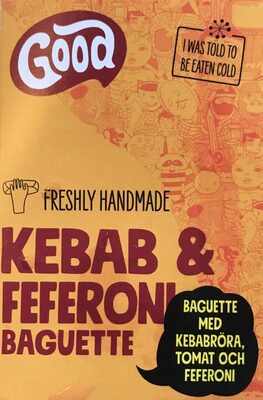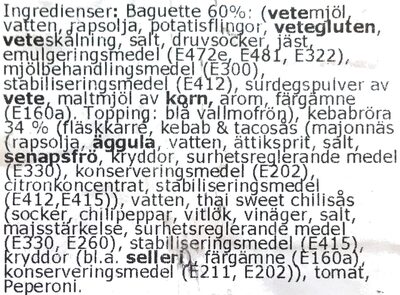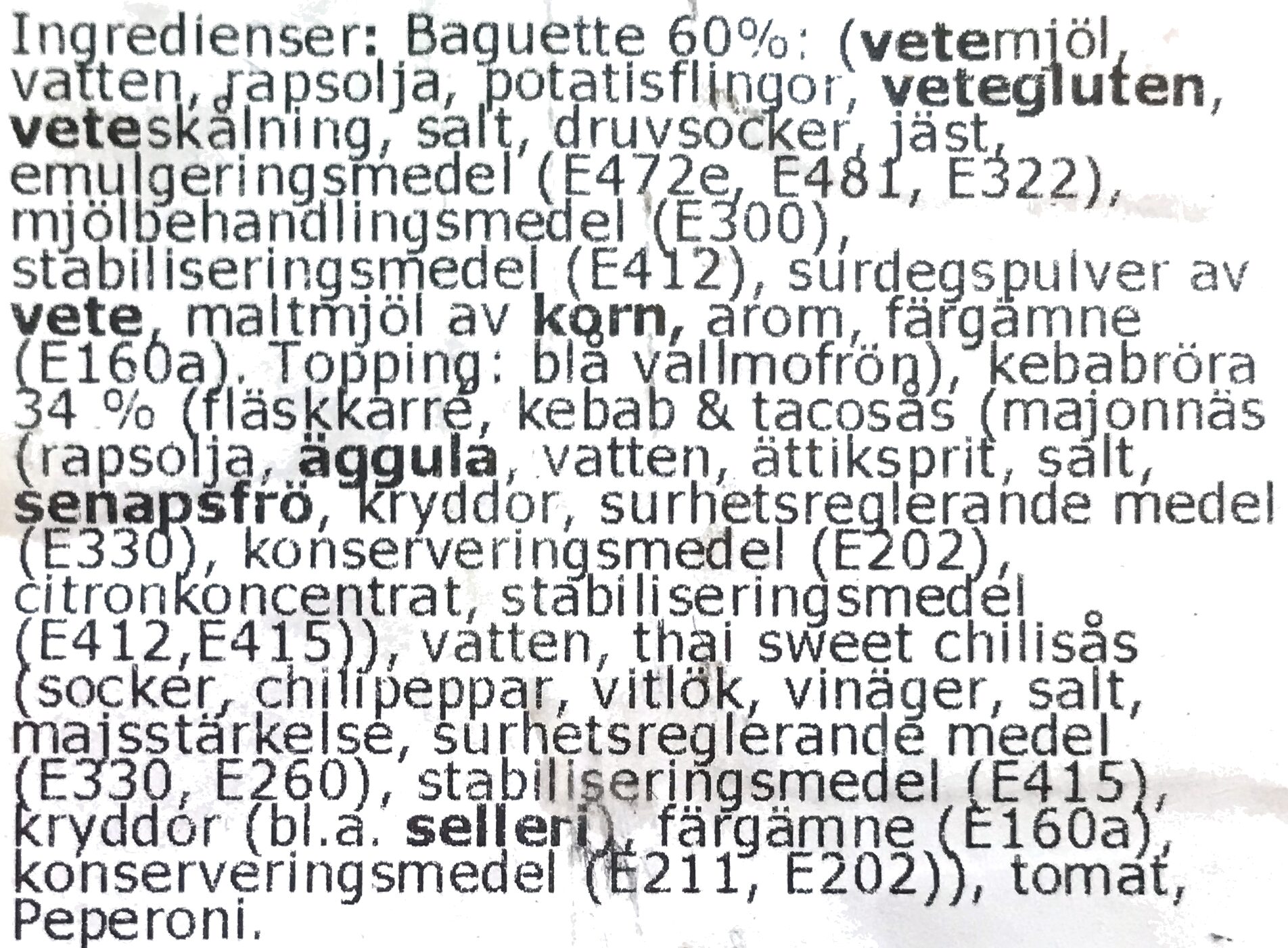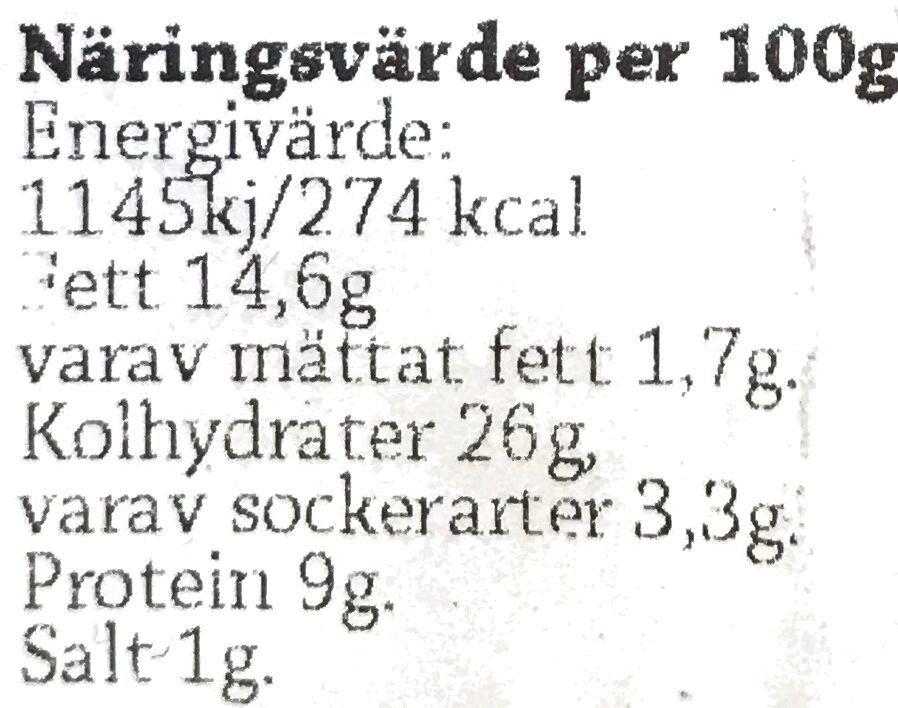Help us make food transparency the norm!
As a non-profit organization, we depend on your donations to continue informing consumers around the world about what they eat.
The food revolution starts with you!
Kebab & Feferoni Baguette - Good - 235 g
Kebab & Feferoni Baguette - Good - 235 g
This product page is not complete. You can help to complete it by editing it and adding more data from the photos we have, or by taking more photos using the app for Android or iPhone/iPad. Thank you!
×
Streckkod: 7330247303040 (EAN / EAN-13)
Kvantitet: 235 g
Varumärken: Good, Nordic Lunch
Butiker: Sparhallen Åland
Matching with your preferences
Hälsa
Ingredienser
-
66 ingredienser
Baguette 60% (vetemjöl, vatten, rapsolja, potatisflingor, vetegluten, veteskåļning, salt, druvsocker, jäst, emulgeringsmedel (E472e, E481, E322), mjölbehandlingsmedel (E300), stabiliseringsmedel (E412), surdegspulver av vete, maltmjöl av korn, arom, färgämne (E160a), Topping (blå vallmofrön)), kebabröra 34 % (fläskkarré, kebab & tacosås (majonnäs (rapsolją, äggula, vatten, ättiksprit, salt, senapsfrö, kryddor, surhetsreglerande medel (E330), konserveringsmedel (E202) citronkoncentrat, stabiliseringsmedel (E412,E415)), vatten, thai sweet chilisås (socker, chilipeppar, vitlök, vinäger, salt, majsstärkelse, surhetsreglerande medel (E330, E260), stabiliseringsmedel (E415), kryddor (bl.a. selleri), färgämne (E160a), konserveringssmedel (E211, E202)), tomat, Peperoni.Allergener: Ägg, Gluten, Senap, Veteskåļning, Veteskåļning
Food processing
-
Ultra processed foods
Elements that indicate the product is in the 4 - Ultra bearbetade livsmedel och drycker group:
- Tillsats: E160a - Karoten
- Tillsats: E322 - Lecitiner
- Tillsats: E412 - Guarkärnmjöl
- Tillsats: E415 - Xantangummi
- Tillsats: E472e - Mono- och diglyceriders mono- och diacetylvinsyraestrar
- Tillsats: E481 - Natriumstearoyl-2-laktylat
- Ingrediens: Färg
- Ingrediens: Emulgeringsmedel
- Ingrediens: Arom
- Ingrediens: Gluten
Food products are classified into 4 groups according to their degree of processing:
- Obearbetade eller minimalt bearbetade livsmedel
- Bearbetade kulinariska ingredienser
- Halvfabrikat
- Ultra processed foods
The determination of the group is based on the category of the product and on the ingredients it contains.
Tillsatser
-
E160a - Karoten
Carotene: The term carotene -also carotin, from the Latin carota, "carrot"- is used for many related unsaturated hydrocarbon substances having the formula C40Hx, which are synthesized by plants but in general cannot be made by animals -with the exception of some aphids and spider mites which acquired the synthesizing genes from fungi-. Carotenes are photosynthetic pigments important for photosynthesis. Carotenes contain no oxygen atoms. They absorb ultraviolet, violet, and blue light and scatter orange or red light, and -in low concentrations- yellow light. Carotenes are responsible for the orange colour of the carrot, for which this class of chemicals is named, and for the colours of many other fruits, vegetables and fungi -for example, sweet potatoes, chanterelle and orange cantaloupe melon-. Carotenes are also responsible for the orange -but not all of the yellow- colours in dry foliage. They also -in lower concentrations- impart the yellow coloration to milk-fat and butter. Omnivorous animal species which are relatively poor converters of coloured dietary carotenoids to colourless retinoids have yellowed-coloured body fat, as a result of the carotenoid retention from the vegetable portion of their diet. The typical yellow-coloured fat of humans and chickens is a result of fat storage of carotenes from their diets. Carotenes contribute to photosynthesis by transmitting the light energy they absorb to chlorophyll. They also protect plant tissues by helping to absorb the energy from singlet oxygen, an excited form of the oxygen molecule O2 which is formed during photosynthesis. β-Carotene is composed of two retinyl groups, and is broken down in the mucosa of the human small intestine by β-carotene 15‚15'-monooxygenase to retinal, a form of vitamin A. β-Carotene can be stored in the liver and body fat and converted to retinal as needed, thus making it a form of vitamin A for humans and some other mammals. The carotenes α-carotene and γ-carotene, due to their single retinyl group -β-ionone ring-, also have some vitamin A activity -though less than β-carotene-, as does the xanthophyll carotenoid β-cryptoxanthin. All other carotenoids, including lycopene, have no beta-ring and thus no vitamin A activity -although they may have antioxidant activity and thus biological activity in other ways-. Animal species differ greatly in their ability to convert retinyl -beta-ionone- containing carotenoids to retinals. Carnivores in general are poor converters of dietary ionone-containing carotenoids. Pure carnivores such as ferrets lack β-carotene 15‚15'-monooxygenase and cannot convert any carotenoids to retinals at all -resulting in carotenes not being a form of vitamin A for this species-; while cats can convert a trace of β-carotene to retinol, although the amount is totally insufficient for meeting their daily retinol needs.Källa: Wikipedia (Engelska)
-
E202 - Kaliumsorbat
Potassium sorbate: Potassium sorbate is the potassium salt of sorbic acid, chemical formula CH3CH=CH−CH=CH−CO2K. It is a white salt that is very soluble in water -58.2% at 20 °C-. It is primarily used as a food preservative -E number 202-. Potassium sorbate is effective in a variety of applications including food, wine, and personal-care products. While sorbic acid is naturally occurring in some berries, virtually all of the world's production of sorbic acid, from which potassium sorbate is derived, is manufactured synthetically.Källa: Wikipedia (Engelska)
-
E211 - Natriumbensoat
Sodium benzoate: Sodium benzoate is a substance which has the chemical formula NaC7H5O2. It is a widely used food preservative, with an E number of E211. It is the sodium salt of benzoic acid and exists in this form when dissolved in water. It can be produced by reacting sodium hydroxide with benzoic acid.Källa: Wikipedia (Engelska)
-
E260 - Ättiksyra
Acetic acid: Acetic acid , systematically named ethanoic acid , is a colorless liquid organic compound with the chemical formula CH3COOH -also written as CH3CO2H or C2H4O2-. When undiluted, it is sometimes called glacial acetic acid. Vinegar is no less than 4% acetic acid by volume, making acetic acid the main component of vinegar apart from water. Acetic acid has a distinctive sour taste and pungent smell. In addition to household vinegar, it is mainly produced as a precursor to polyvinyl acetate and cellulose acetate. It is classified as a weak acid since it only partially dissociates in solution, but concentrated acetic acid is corrosive and can attack the skin. Acetic acid is the second simplest carboxylic acid -after formic acid-. It consists of a methyl group attached to a carboxyl group. It is an important chemical reagent and industrial chemical, used primarily in the production of cellulose acetate for photographic film, polyvinyl acetate for wood glue, and synthetic fibres and fabrics. In households, diluted acetic acid is often used in descaling agents. In the food industry, acetic acid is controlled by the food additive code E260 as an acidity regulator and as a condiment. In biochemistry, the acetyl group, derived from acetic acid, is fundamental to all forms of life. When bound to coenzyme A, it is central to the metabolism of carbohydrates and fats. The global demand for acetic acid is about 6.5 million metric tons per year -Mt/a-, of which approximately 1.5 Mt/a is met by recycling; the remainder is manufactured from methanol. Vinegar is mostly dilute acetic acid, often produced by fermentation and subsequent oxidation of ethanol.Källa: Wikipedia (Engelska)
-
E322 - Lecitiner
Lecithin: Lecithin -UK: , US: , from the Greek lekithos, "egg yolk"- is a generic term to designate any group of yellow-brownish fatty substances occurring in animal and plant tissues, which are amphiphilic – they attract both water and fatty substances -and so are both hydrophilic and lipophilic-, and are used for smoothing food textures, dissolving powders -emulsifying-, homogenizing liquid mixtures, and repelling sticking materials.Lecithins are mixtures of glycerophospholipids including phosphatidylcholine, phosphatidylethanolamine, phosphatidylinositol, phosphatidylserine, and phosphatidic acid.Lecithin was first isolated in 1845 by the French chemist and pharmacist Theodore Gobley. In 1850, he named the phosphatidylcholine lécithine. Gobley originally isolated lecithin from egg yolk—λέκιθος lekithos is "egg yolk" in Ancient Greek—and established the complete chemical formula of phosphatidylcholine in 1874; in between, he had demonstrated the presence of lecithin in a variety of biological matters, including venous blood, in human lungs, bile, human brain tissue, fish eggs, fish roe, and chicken and sheep brain. Lecithin can easily be extracted chemically using solvents such as hexane, ethanol, acetone, petroleum ether, benzene, etc., or extraction can be done mechanically. It is usually available from sources such as soybeans, eggs, milk, marine sources, rapeseed, cottonseed, and sunflower. It has low solubility in water, but is an excellent emulsifier. In aqueous solution, its phospholipids can form either liposomes, bilayer sheets, micelles, or lamellar structures, depending on hydration and temperature. This results in a type of surfactant that usually is classified as amphipathic. Lecithin is sold as a food additive and dietary supplement. In cooking, it is sometimes used as an emulsifier and to prevent sticking, for example in nonstick cooking spray.Källa: Wikipedia (Engelska)
-
E330 - Citronsyra
Citric acid: Citric acid is a weak organic acid that has the chemical formula C6H8O7. It occurs naturally in citrus fruits. In biochemistry, it is an intermediate in the citric acid cycle, which occurs in the metabolism of all aerobic organisms. More than a million tons of citric acid are manufactured every year. It is used widely as an acidifier, as a flavoring and chelating agent.A citrate is a derivative of citric acid; that is, the salts, esters, and the polyatomic anion found in solution. An example of the former, a salt is trisodium citrate; an ester is triethyl citrate. When part of a salt, the formula of the citrate ion is written as C6H5O3−7 or C3H5O-COO-3−3.Källa: Wikipedia (Engelska)
-
E412 - Guarkärnmjöl
Guar gum: Guar gum, also called guaran, is a galactomannan polysaccharide extracted from guar beans that has thickening and stabilizing properties useful in the food, feed and industrial applications. The guar seeds are mechanically dehusked, hydrated, milled and screened according to application. It is typically produced as a free-flowing, off-white powder.Källa: Wikipedia (Engelska)
-
E415 - Xantangummi
Xanthan gum: Xanthan gum -- is a polysaccharide with many industrial uses, including as a common food additive. It is an effective thickening agent and stabilizer to prevent ingredients from separating. It can be produced from simple sugars using a fermentation process, and derives its name from the species of bacteria used, Xanthomonas campestris.Källa: Wikipedia (Engelska)
-
E481 - Natriumstearoyl-2-laktylat
Sodium stearoyl lactylate: Sodium stearoyl-2-lactylate -sodium stearoyl lactylate or SSL- is a versatile, FDA approved food additive used to improve the mix tolerance and volume of processed foods. It is one type of a commercially available lactylate. SSL is non-toxic, biodegradable, and typically manufactured using biorenewable feedstocks. Because SSL is a safe and highly effective food additive, it is used in a wide variety of products ranging from baked goods and desserts to pet foods.As described by the Food Chemicals Codex 7th edition, SSL is a cream-colored powder or brittle solid. SSL is currently manufactured by the esterification of stearic acid with lactic acid and partially neutralized with either food-grade soda ash -sodium carbonate- or caustic soda -concentrated sodium hydroxide-. Commercial grade SSL is a mixture of sodium salts of stearoyl lactylic acids and minor proportions of other sodium salts of related acids. The HLB for SSL is 10-12. SSL is slightly hygroscopic, soluble in ethanol and in hot oil or fat, and dispersible in warm water. These properties are the reason that SSL is an excellent emulsifier for fat-in-water emulsions and can also function as a humectant.Källa: Wikipedia (Engelska)
Ingrediensanalys
-
Kan innehålla palmolja
Ingredienser som kan innehålla palmolja: E472e, E481, E160a, E160a
-
Icke-vegan
Non-vegan ingredients: Karré, ÄggulaVissa ingredienser kunde inte kännas igen.
Vi behöver din hjälp!
You can help us recognize more ingredients and better analyze the list of ingredients for this product and others:
- Edit this product page to correct spelling mistakes in the ingredients list, and/or to remove ingredients in other languages and sentences that are not related to the ingredients.
- Add new entries, synonyms or translations to our multilingual lists of ingredients, ingredient processing methods, and labels.
If you would like to help, join the #ingredients channel on our Slack discussion space and/or learn about ingredients analysis on our wiki. Thank you!
-
Icke-vegetarisk
Non-vegetarian ingredients: KarréVissa ingredienser kunde inte kännas igen.
Vi behöver din hjälp!
You can help us recognize more ingredients and better analyze the list of ingredients for this product and others:
- Edit this product page to correct spelling mistakes in the ingredients list, and/or to remove ingredients in other languages and sentences that are not related to the ingredients.
- Add new entries, synonyms or translations to our multilingual lists of ingredients, ingredient processing methods, and labels.
If you would like to help, join the #ingredients channel on our Slack discussion space and/or learn about ingredients analysis on our wiki. Thank you!
-
Details of the analysis of the ingredients
Vi behöver din hjälp!
Vissa ingredienser kunde inte kännas igen.
Vi behöver din hjälp!
You can help us recognize more ingredients and better analyze the list of ingredients for this product and others:
- Edit this product page to correct spelling mistakes in the ingredients list, and/or to remove ingredients in other languages and sentences that are not related to the ingredients.
- Add new entries, synonyms or translations to our multilingual lists of ingredients, ingredient processing methods, and labels.
If you would like to help, join the #ingredients channel on our Slack discussion space and/or learn about ingredients analysis on our wiki. Thank you!
: Baguette 60% (_vetemjöl_, vatten, rapsolja, potatisflingor, _vetegluten_, _veteskåļning_, salt, druvsocker, jäst, emulgeringsmedel (e472e, e481, e322), mjölbehandlingsmedel (e300), stabiliseringsmedel (e412), surdegspulver av _vete_, maltmjöl av _korn_, arom, färgämne (e160a), Topping (blå vallmofrön)), kebabröra 34%, fläskkarré, kebab och tacosås, majonnäs (rapsolją, _äggula_, vatten, ättiksprit, salt, _senapsfrö_, kryddor, surhetsreglerande medel (e330), konserveringsmedel (e202), citronkoncentrat, stabiliseringsmedel (e412, e415)), vatten, thai sweet chilisås (socker, chilipeppar, vitlök, vinäger, salt, majsstärkelse, surhetsreglerande medel (e330, e260), stabiliseringsmedel (e415), kryddor (bland annat selleri), färgämne (e160a), konserveringssmedel (e211, e202)), tomat, Peperoni- Baguette -> en:baguette - percent_min: 60 - percent: 60 - percent_max: 60
- _vetemjöl_ -> en:wheat-flour - vegan: yes - vegetarian: yes - ciqual_proxy_food_code: 9410 - percent_min: 3.52941176470588 - percent_max: 60
- vatten -> en:water - vegan: yes - vegetarian: yes - ciqual_food_code: 18066 - percent_min: 0 - percent_max: 30
- rapsolja -> en:rapeseed-oil - vegan: yes - vegetarian: yes - from_palm_oil: no - percent_min: 0 - percent_max: 20
- potatisflingor -> en:potato-flakes - vegan: yes - vegetarian: yes - ciqual_food_code: 4003 - percent_min: 0 - percent_max: 15
- _vetegluten_ -> en:wheat-gluten - vegan: yes - vegetarian: yes - percent_min: 0 - percent_max: 12
- _veteskåļning_ -> sv:veteskåļning - percent_min: 0 - percent_max: 10
- salt -> en:salt - vegan: yes - vegetarian: yes - ciqual_food_code: 11058 - percent_min: 0 - percent_max: 1
- druvsocker -> en:grape-sugar - percent_min: 0 - percent_max: 1
- jäst -> en:yeast - vegan: yes - vegetarian: yes - percent_min: 0 - percent_max: 1
- emulgeringsmedel -> en:emulsifier - percent_min: 0 - percent_max: 1
- e472e -> en:e472e - vegan: maybe - vegetarian: maybe - from_palm_oil: maybe - percent_min: 0 - percent_max: 1
- e481 -> en:e481 - vegan: maybe - vegetarian: maybe - from_palm_oil: maybe - percent_min: 0 - percent_max: 0.5
- e322 -> en:e322 - vegan: maybe - vegetarian: maybe - percent_min: 0 - percent_max: 0.333333333333333
- mjölbehandlingsmedel -> en:flour-treatment-agent - percent_min: 0 - percent_max: 1
- e300 -> en:e300 - vegan: yes - vegetarian: yes - percent_min: 0 - percent_max: 1
- stabiliseringsmedel -> en:stabiliser - percent_min: 0 - percent_max: 1
- e412 -> en:e412 - vegan: yes - vegetarian: yes - percent_min: 0 - percent_max: 1
- surdegspulver av _vete_ -> sv:surdegspulver-av-vete - percent_min: 0 - percent_max: 1
- maltmjöl av _korn_ -> en:barley-malt-flour - vegan: yes - vegetarian: yes - ciqual_food_code: 9550 - percent_min: 0 - percent_max: 1
- arom -> en:flavouring - vegan: maybe - vegetarian: maybe - percent_min: 0 - percent_max: 1
- färgämne -> en:colour - percent_min: 0 - percent_max: 1
- e160a -> en:e160a - vegan: maybe - vegetarian: maybe - from_palm_oil: maybe - percent_min: 0 - percent_max: 1
- Topping -> sv:topping - percent_min: 0 - percent_max: 1
- blå vallmofrön -> sv:blå-vallmofrön - percent_min: 0 - percent_max: 1
- kebabröra -> sv:kebabröra - percent_min: 34 - percent: 34 - percent_max: 34
- fläskkarré -> en:boston-butt - vegan: no - vegetarian: no - ciqual_food_code: 28104 - percent_min: 0.857142857142857 - percent_max: 6
- kebab och tacosås -> sv:kebab-och-tacosås - percent_min: 0 - percent_max: 3
- majonnäs -> en:mayonnaise - vegan: maybe - vegetarian: maybe - ciqual_food_code: 11054 - percent_min: 0 - percent_max: 2
- rapsolją -> sv:rapsolją - percent_min: 0 - percent_max: 2
- _äggula_ -> en:egg-yolk - vegan: no - vegetarian: yes - ciqual_food_code: 22002 - percent_min: 0 - percent_max: 0.999999999999999
- vatten -> en:water - vegan: yes - vegetarian: yes - ciqual_food_code: 18066 - percent_min: 0 - percent_max: 0.666666666666666
- ättiksprit -> en:alcohol-vinegar - vegan: yes - vegetarian: yes - ciqual_food_code: 11018 - percent_min: 0 - percent_max: 0.5
- salt -> en:salt - vegan: yes - vegetarian: yes - ciqual_food_code: 11058 - percent_min: 0 - percent_max: 0.4
- _senapsfrö_ -> en:mustard-seed - vegan: yes - vegetarian: yes - ciqual_food_code: 11013 - percent_min: 0 - percent_max: 0.333333333333333
- kryddor -> en:spice - vegan: yes - vegetarian: yes - percent_min: 0 - percent_max: 0.285714285714285
- surhetsreglerande medel -> en:acidity-regulator - percent_min: 0 - percent_max: 0.285714285714285
- e330 -> en:e330 - vegan: yes - vegetarian: yes - percent_min: 0 - percent_max: 0.285714285714285
- konserveringsmedel -> en:preservative - percent_min: 0 - percent_max: 0.222222222222222
- e202 -> en:e202 - vegan: yes - vegetarian: yes - percent_min: 0 - percent_max: 0.222222222222222
- citronkoncentrat -> en:concentrated-lemon-juice - vegan: yes - vegetarian: yes - ciqual_food_code: 2028 - percent_min: 0 - percent_max: 0.2
- stabiliseringsmedel -> en:stabiliser - percent_min: 0 - percent_max: 0.2
- e412 -> en:e412 - vegan: yes - vegetarian: yes - percent_min: 0 - percent_max: 0.2
- e415 -> en:e415 - vegan: yes - vegetarian: yes - percent_min: 0 - percent_max: 0.111111111111111
- vatten -> en:water - vegan: yes - vegetarian: yes - ciqual_food_code: 18066 - percent_min: 0 - percent_max: 1.5
- thai sweet chilisås -> sv:thai-sweet-chilisås - percent_min: 0 - percent_max: 1.2
- socker -> en:sugar - vegan: yes - vegetarian: yes - ciqual_proxy_food_code: 31016 - percent_min: 0 - percent_max: 1.2
- chilipeppar -> en:chili-pepper - vegan: yes - vegetarian: yes - ciqual_food_code: 20151 - percent_min: 0 - percent_max: 0.6
- vitlök -> en:garlic - vegan: yes - vegetarian: yes - ciqual_food_code: 11000 - percent_min: 0 - percent_max: 0.4
- vinäger -> en:vinegar - vegan: yes - vegetarian: yes - ciqual_food_code: 11018 - percent_min: 0 - percent_max: 0.3
- salt -> en:salt - vegan: yes - vegetarian: yes - ciqual_food_code: 11058 - percent_min: 0 - percent_max: 0.24
- majsstärkelse -> en:corn-starch - vegan: yes - vegetarian: yes - ciqual_food_code: 9510 - percent_min: 0 - percent_max: 0.2
- surhetsreglerande medel -> en:acidity-regulator - percent_min: 0 - percent_max: 0.2
- e330 -> en:e330 - vegan: yes - vegetarian: yes - percent_min: 0 - percent_max: 0.2
- e260 -> en:e260 - vegan: yes - vegetarian: yes - percent_min: 0 - percent_max: 0.12
- stabiliseringsmedel -> en:stabiliser - percent_min: 0 - percent_max: 0.2
- e415 -> en:e415 - vegan: yes - vegetarian: yes - percent_min: 0 - percent_max: 0.2
- kryddor -> en:spice - vegan: yes - vegetarian: yes - percent_min: 0 - percent_max: 0.133333333333333
- bland annat selleri -> en:celery - vegan: yes - vegetarian: yes - ciqual_proxy_food_code: 20055 - percent_min: 0 - percent_max: 0.133333333333333
- färgämne -> en:colour - percent_min: 0 - percent_max: 0.12
- e160a -> en:e160a - vegan: maybe - vegetarian: maybe - from_palm_oil: maybe - percent_min: 0 - percent_max: 0.12
- konserveringssmedel -> sv:konserveringssmedel - percent_min: 0 - percent_max: 0.12
- e211 -> en:e211 - vegan: yes - vegetarian: yes - percent_min: 0 - percent_max: 0.12
- e202 -> en:e202 - vegan: yes - vegetarian: yes - percent_min: 0 - percent_max: 0.12
- tomat -> en:tomato - vegan: yes - vegetarian: yes - ciqual_food_code: 20047 - percent_min: 0 - percent_max: 0.999999999999999
- Peperoni -> sv:peperoni - percent_min: 0 - percent_max: 0.857142857142857
Näring
-
Missing data to compute the Nutri-Score
Missing category
⚠ ️The category of the product must be specified in order to compute the Nutri-Score.Could you add the information needed to compute the Nutri-Score? Lägg till en kategori
-
Näringsfakta
Näringsfakta Som såld
för 100 g / 100 mlSom såld
per portion (235 g)Energi 1 145 kj
(274 kcal)2 690 kj
(644 kcal)Fett 14,6 g 34,3 g Mättat fett 1,7 g 4 g Kolhydrat 26 g 61,1 g Sockerarter 3,3 g 7,76 g Fiber ? ? Protein 9 g 21,1 g Salt 1 g 2,35 g Fruits‚ vegetables‚ nuts and rapeseed‚ walnut and olive oils (estimate from ingredients list analysis) 7,2 % 7,2 %
Miljö
-
Eco-score ej beräknad - Okänd miljöpåverkan
Vi kunde inte beräkna Eco-Score av denna produkt eftersom det saknas vissa data, kan du hjälpa till att slutföra det?Could you add a precise product category so that we can compute the Eco-Score? Lägg till en kategori
Förpackning
-
Missing packaging information for this product
⚠ ️ The information about the packaging of this product is not filled in.Take a photo of the recycling information Take a photo of the recycling information
Transportation
-
Origins of ingredients
Missing origins of ingredients information
⚠ ️ The origins of the ingredients of this product are not indicated.
If they are indicated on the packaging, you can modify the product sheet and add them.
If you are the manufacturer of this product, you can send us the information with our free platform for producers.Add the origins of ingredients for this product Add the origins of ingredients for this product
Report a problem
-
Incomplete or incorrect information?
Category, labels, ingredients, allergens, nutritional information, photos etc.
If the information does not match the information on the packaging, please complete or correct it. Open Food Facts is a collaborative database, and every contribution is useful for all.
Datakällor
Produkt tillagd den av dahlqvist
Senast ändrad produktsida på av dahlqvist.
Produktsida också redigerad av hungergames.








